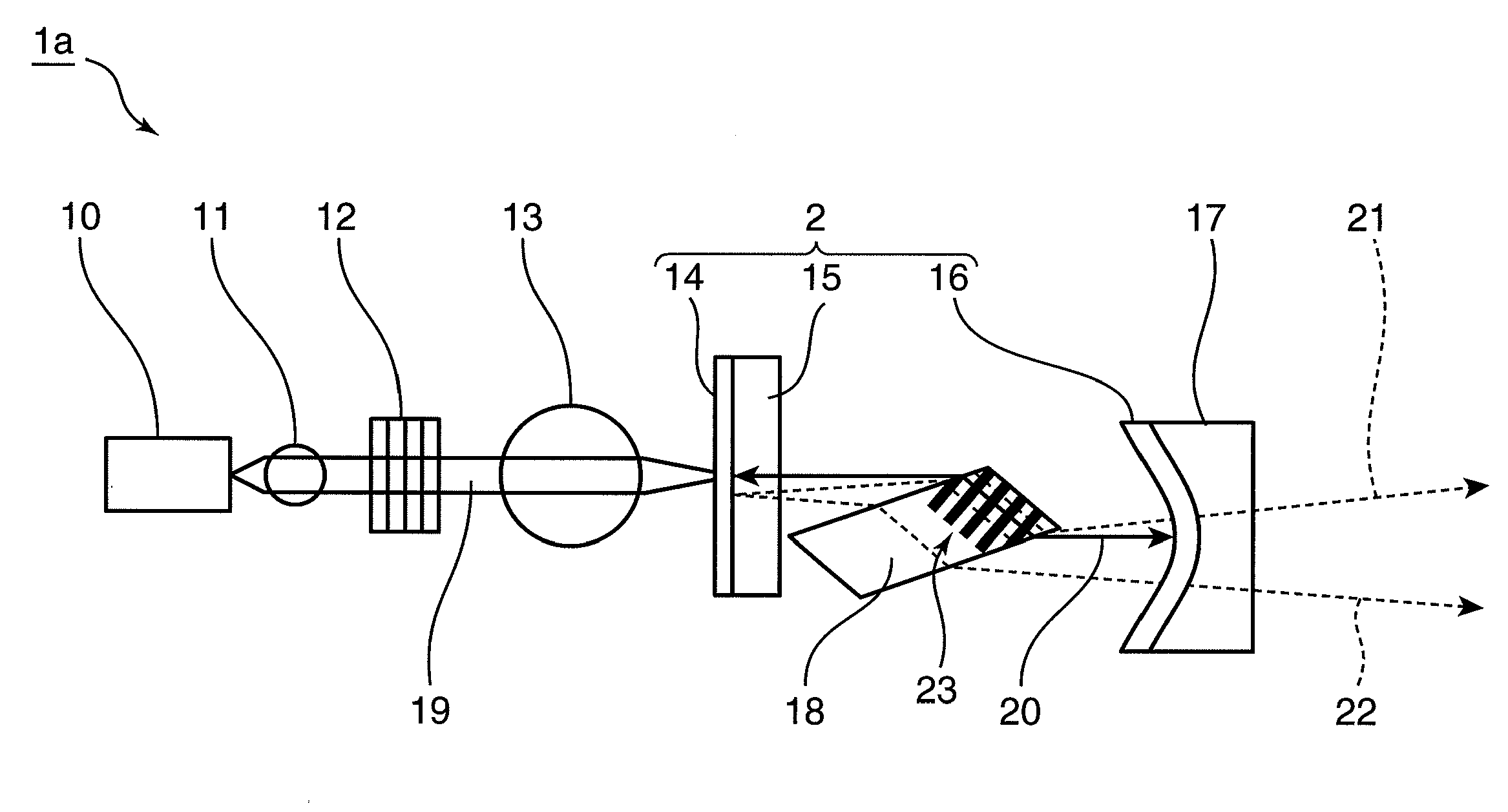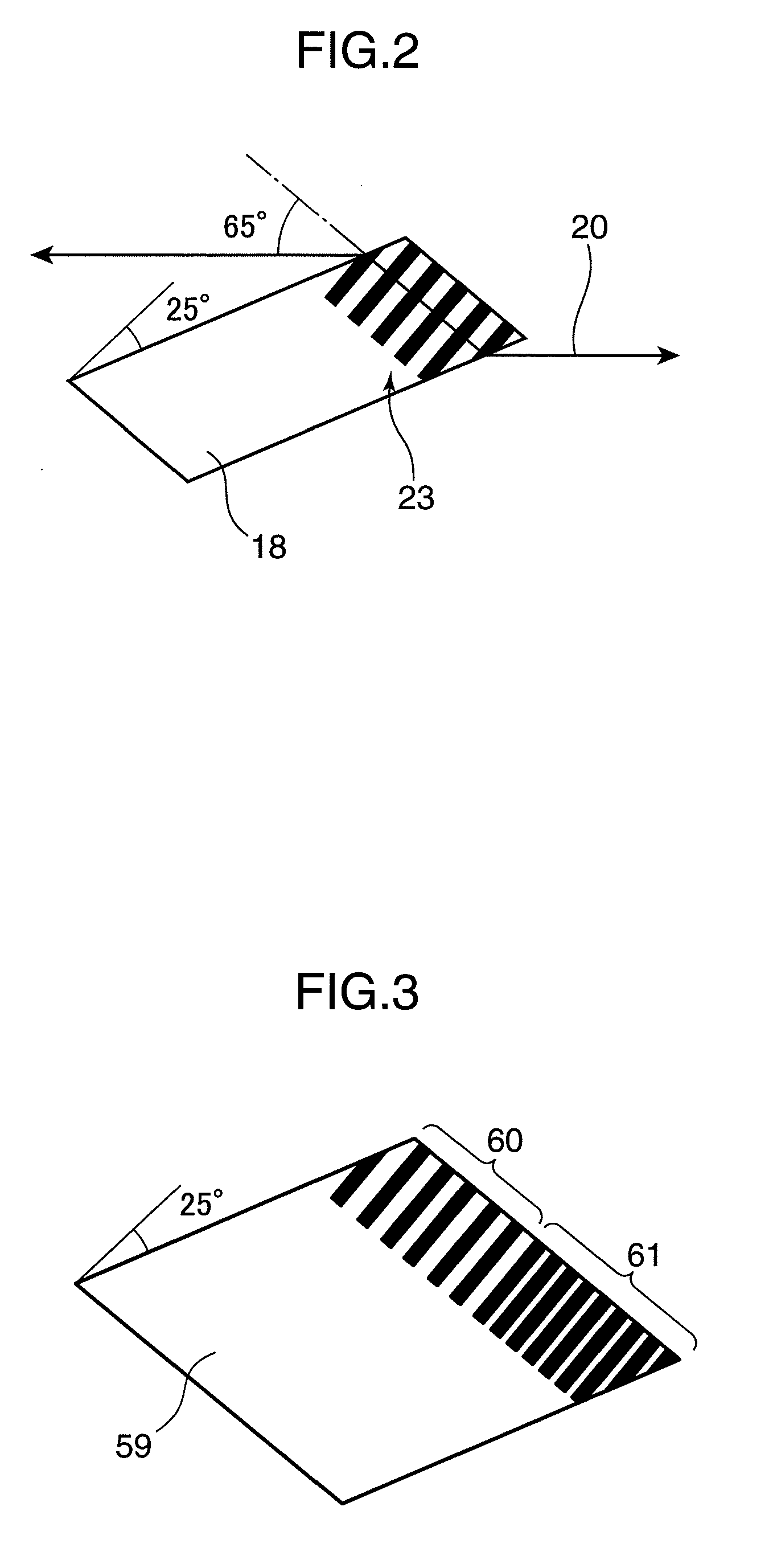Solid-state laser device and image display device
a laser device and laser technology, applied in the direction of optical elements, planar/plate-like light guides, instruments, etc., can solve the problems of unstable output, difficult to obtain a high output, unstable harmonic output, etc., and achieve the effect of not increasing the number of parts
- Summary
- Abstract
- Description
- Claims
- Application Information
AI Technical Summary
Benefits of technology
Problems solved by technology
Method used
Image
Examples
first embodiment
[0044]FIG. 1 is a diagram showing the construction of an internal resonator type solid-state laser device 1a according to a first embodiment of the present invention. The solid-state laser device 1a of the first embodiment is provided with a semiconductor laser light source 10, a rod lens 11, a volume Bragg grating (hereinafter, referred to as VBG) 12, a ball lens 13, an optical resonator 2, a concave mirror 17 and a wavelength conversion element 18.
[0045]The semiconductor laser light source 10 emits a laser beam for pumping (hereinafter, referred to as pump beam) 19. The optical resonator 2 is comprised of a solid laser crystal 15 to be excited by the incidence of the pump beam 19 to oscillate a fundamental wave 20 and a pair of fundamental wave reflective coats 14, 16 arranged at the opposite sides of the solid laser crystal 15. The wavelength conversion element 18 is arranged in the optical resonator 2 for converting the fundamental wave 20 into a plurality of harmonics 21, 22.
[0...
second embodiment
[0067]In a second embodiment is described an example in which a wavelength conversion element formed with a plurality of polarization reversal regions with different periods is used by being inserted into an optical resonator. The wavelength conversion element used in the second embodiment is obliquely ground and inserted at a Brewster angle into the optical resonator similar to the first embodiment.
[0068]FIG. 3 is a diagram showing the construction of a wavelength conversion element 59 used in a solid-state laser device according to the second embodiment of the present invention. In the second embodiment, the construction other than the wavelength conversion element 59 is the same as the solid-state laser device of the first embodiment. As shown in FIG. 3, the wavelength conversion element 59 is formed with a first polarization reversal region 60 and a second polarization reversal region 61 with a period different from that of the first polarization reversal region 60.
[0069]FIG. 4 ...
third embodiment
[0077]In a third embodiment is described an example in which a plurality of obliquely ground wavelength conversion elements are inserted at a Brewster angle into an optical resonator.
[0078]FIG. 5 is a diagram showing the construction of a solid-state laser device according to the third embodiment of the present invention. A solid-state laser device 1b shown in FIG. 5 is provided with a semiconductor laser light source 10, a rod lens 11, a VBG 12, a ball lens 13, an optical resonator 2, a concave mirror 17 and wavelength conversion elements 18, 24. A basic construction of the solid-state laser device 1b of the third embodiment is similar to that of the solid-state laser device 1a of the first embodiment, but the wavelength conversion element 24 is inserted in the optical resonator 2.
[0079]As shown in FIG. 5, the number of harmonics to be output increases by adding the wavelength conversion element 24 between the wavelength conversion element 18 and a fundamental wave reflective coat ...
PUM
 Login to View More
Login to View More Abstract
Description
Claims
Application Information
 Login to View More
Login to View More - R&D
- Intellectual Property
- Life Sciences
- Materials
- Tech Scout
- Unparalleled Data Quality
- Higher Quality Content
- 60% Fewer Hallucinations
Browse by: Latest US Patents, China's latest patents, Technical Efficacy Thesaurus, Application Domain, Technology Topic, Popular Technical Reports.
© 2025 PatSnap. All rights reserved.Legal|Privacy policy|Modern Slavery Act Transparency Statement|Sitemap|About US| Contact US: help@patsnap.com



